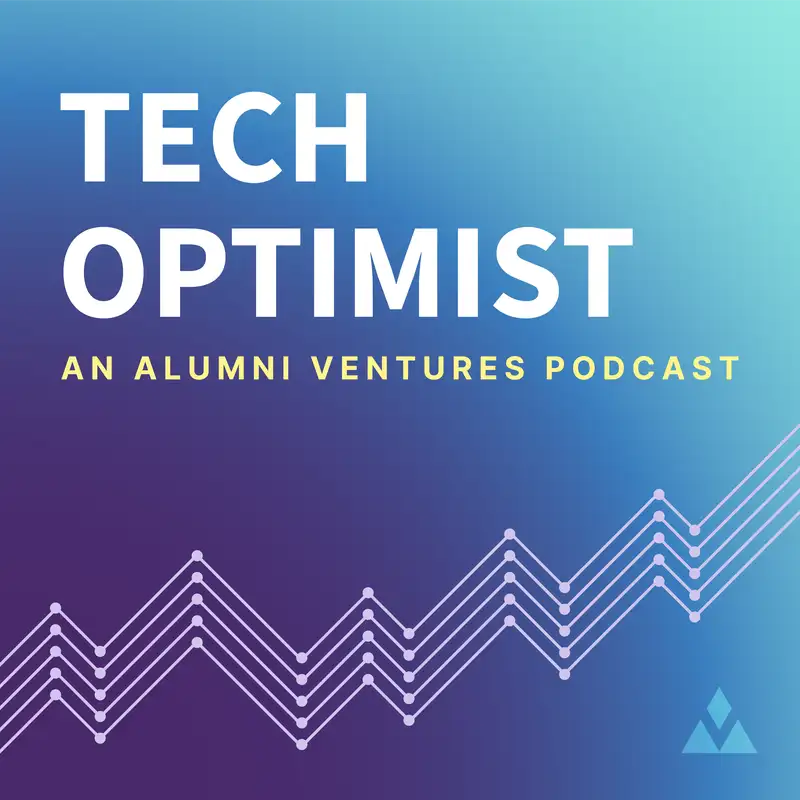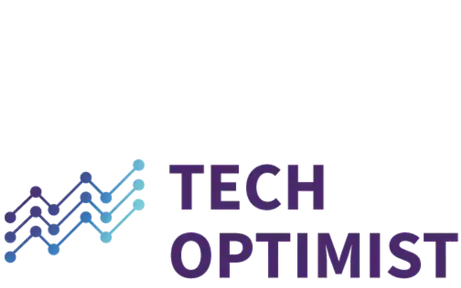#72 - Three Breakthroughs: AI and Nuclear Energy
Sam:
This podcast is brought to you by Alumni Ventures. Welcome to The Tech Optimist. This is a show where we discuss the people and innovations shaping our future.
Mike Collins:
We're going to need to add three to 10 Japans pretty quickly.
Sam:
That is the Alumni Ventures co-founder and CEO Mike Collins.
Naren Ramaswamy:
What is that going to mean for cities? What is that going to mean for the future of work?
Sam:
That is Naren Ramaswamy, senior principal at Alumni Ventures. And my name is Sam. I am The Tech Optimist narrative writer and guide for this show. Okay, welcome back to another Three Breakthroughs episode of The Tech Optimist. We are at episode 72. That is crazy. That means there have been a lot of breakthroughs in this podcast. And again, I really like this whole niche that we're running with where I don't want to spoil the breakthroughs for you.
The editors and I, secret or a thing we get to enjoy or look forward to each time one of these comes out is actually learning what the breakthroughs are as we watch and as we edit. So I'll give you some hints again for the breakthroughs today. We've got nuclear energy. We've got Elon Musk again. Yes, again, second week in a row. And then we have cancer detection. So I'm going to leave it up to that.
Before we do anything, you guys know the drill. We're going to hop into an AV, ad and then a quick disclaimer, and then we'll hop right into the show. So sit back, relax, get comfortable, throw those headphones on, turn that volume a little bit up on your car speaker or speakers, wherever you are, and enjoy.
AV ad:
Do you have a venture capital portfolio of cutting edge startups? Without one, you could be missing out on enormous value creation and a more diversified personal portfolio. Alumni Ventures, ranked a top 20 VC firm by CB Insights, is the leading VC firm for individual investors. Believe in investing in innovation? Visit av.vc/foundation to get started.
Sam:
As a reminder, The Tech Optimist Podcast is for the informational purposes only. It's not personalized advice, and it's not an offer to buy or sell securities. For additional important details, please see the text description accompanying this episode.
Mike Collins:
Hello, again. Welcome to Tech Optimist. This is our Three Breakthroughs show where we get together and talk about things that are happening in the news, in the area of science and technology that informs where we as venture capitalists are looking either today or down the road in the future.
So I'm here. I'm Mike Collins. I'm the founder and CEO of Alumni Ventures. We've been around a decade, one of the more active venture capital firms in the United States. And I'm joined by one of my partners, who's out in the other coast, Naren Ramaswamy. Hi, Naren.
Naren Ramaswamy:
Hey, Mike. How are you?
Mike Collins:
I'm good. So I'm going to kick it off today, and I think this is something that probably everybody's familiar with, but AI and nuclear. We're seeing that we're moving beyond the China syndrome days, which is callback to an old movie for folks like me, and really I think a lot of fear, a lot of it, in my opinion, fairly misplaced if you look at the data around nuclear energy. And it's mostly around first generation types of platforms. We're now on generation three or sometimes even generation four.
And so it's a little bit comparing apples to oranges, but it's been slow. And in the United States there's been really until recently a real lack of activity in this area. A lot of talk about new technologies, small reactors. But I think with AI, we're really starting to see a lot more attention and demand and the private sector really pushing the needle. And I also just think a change in perspective. The whole gestalt of how we're thinking about energy and not really just saying, "Oh, fracking is bad. Solar is good."
But we need it all and we need to do it responsibly. But I believe the number is something like 300 in China are either active or in development, huge aggressive plans. And we all believe that it's in the strategic interests of the United States to be good at AI. And in order to do AI, one needs a lot of energy and a lot of power.
Sam:
All right, it's my turn to butt in here. So when Mike talks about AI and nuclear energy, my head first goes to nuclear energy to power these data centers and then these data centers are used to generate AI models. I am not a AI specialist. I'm not an engineer or a computer scientist. Anyway, but that's the general gist of what is going on here. So I just looked up more information on using nuclear energy to power AI data centers, and so this is what I found.
Google announced a partnership with Kairos Power, I hope I'm saying that right, to use compact nuclear reactors for its AI data centers with the first reactor expected to be operational within this decade. Amazon has invested in small nuclear reactors and is collaborating with Dominion Energy to explore installing a small nuclear reactor near an existing nuclear facility in Virginia. And Microsoft entered an agreement to purchase electricity from the reactivated Three Mile Island Nuclear facility.
So some general motivations for this type of energy production is just the increased energy demand. So data centers, especially those supporting AI technologies, require substantial amounts of electricity. Clean energy goals. Nuclear power is nearly carbon neutral, helping tech companies meet their emission reduction commitments, which is a huge thing the US is trying to accomplish recently. Nuclear plants provide consistent baseload power that aligns well with data centers' 24/7 energy needs reliably.
And the scalability. So small modular reactors, SMRs, offer a more flexible, scalable solution for data center power needs. As far as industry impact and some challenges along the road, the International Energy Agency projects data center electricity consumption could exceed 1,000 terawatt hours by 2026, more than double the 2022 usage. Nuclear power is seen as a solution to the energy trilemma of affordability, sustainability, and reliability for data centers.
Co-locating data centers with nuclear plans is being explored as an efficient way to meet power demands without straining the existing grid infrastructure. Sounds like a win-win, right? On the other hand, some challenges with this. Some utilities have expressed concerns about how direct agreements between tech companies and nuclear plants could affect the electrical grid. The development of new nuclear technologies, especially SMRs, is still ongoing with none currently supplying power to the US grid.
So we're very in the early stages of this and balancing the power needs of data centers with those of other consumers remains a consideration. So this trend represents a significant shift in how tech companies are approaching their energy needs, potentially reshaping both the data center industry and the future of nuclear power in the United States.
Mike Collins:
I think it's one of those cases that we have seen the history of mankind, if you create the energy, it will get used. I just think what we need is going to create a economic imperative for us to really make a move here. And so again, we're seeing Amazon, Microsoft, OpenAI, Sam Altman making investments, Bill Gates' personal investments, Bill Gates being a player. Again, a whole range of technologies.
I think there's a whole range of soft commitments, hard commitments, but I think what I want to point out as one of the three breakthroughs is the US private sector is going all in on this and big finance as well. So there has been a lot of big money managers, a lot of people who push around billions and tens of billions of dollars looking to finance these things.
I think it's a big story that's not getting lots of play, but I think it's a big bit of news. I think the fact that private companies are really saying, "Okay, I'm building data centers. I need to power these data centers. This is the best way for me to do it. And it's not being anti-solar, renewables or anything like that. It's just we need those things too." What do you think Naren?
Naren Ramaswamy:
I mean, I think there's the old adage, necessity is the mother of invention And this is the biggest evidence that there is a necessity for this new power. I mean, I think we're going to end up in a situation very soon where AI models and algorithms are amazing and they have great capability, but the limiting factor is going to be the energy consumption. And that's where we're headed.
This is a little bit of foresight from Google, Microsoft, Amazon, and these folks who are trying to get ahead of that. I mean, just to share some numbers here, data centers and AI and crypto, which are all power hungry, they account for about 2% of energy use. This statistic is from 2022, and that is expected to double by 2026. This is a four year period were the energy use of these technologies. And now that's going to be roughly the same amount of electricity that is used by the whole country of Japan.
Mike Collins:
Maybe that's the unit of measure. We're going to need to add three to 10 Japans pretty quickly, and this is the only way it's done. You need to use nuclear power either from the big nuclear engine in the sky, but that sets at night, or you're going to have to do it more locally and distribute it.
Sam:
So thinking about this conversation between Mike and Naren, I'm not a nuclear physicist. I'm not a nuclear scientist. I'm not even sure if I know exactly how nuclear power works. So really quick, I'm going to dumb us all down, get us right on the same page on how nuclear power works and what it actually does. So nuclear power originates from the nucleus of atoms, specifically from the fission or splitting of certain heavy elements like uranium or plutonium.
So the process for nuclear fission. Fuel rods containing uranium or plutonium are placed in a reactor core. Neutrons bombard the fuel atoms causing them to split, which is this fission. This fission then releases energy in the form of heat and more neutrons. The released neutrons cause more fissions creating a chain reaction. Heat generation and steam production. So the heat from fission is used to heat water in the reactor.
And in a pressurized water reactor, the most common type, water as the primary coating circuit is kept under high pressure to prevent boiling. And this heated water transfers heat to a secondary circuit in a steam generator. The secondary circuit then produces steam. So electricity generation. The steam drives a turbine connected to a generator. And as the turbine spins, the generator produces electricity. The steam is then cooled in a condenser and recycled back into the system.
So some key components about this whole process that we just talked about. The reactor core, we're going to hop back a few steps, contains fuel rods and controls the fission reaction. Control rods, they regulate the rate of fission. And the coolant, usually water, which also acts as a moderator to slow the neutrons. The steam generator transfers heat from the primary to secondary circuit, and the turbine and generator converts thermal energy to mechanical and then electrical energy.
So nuclear power plants provide a constant supply of baseload power with nearly zero carbon emissions during operation. The entire process designed to efficiently harness the enormous amount of energy released from splitting atoms to generate electricity on a large scale.
Mike Collins:
Again, I think we're seeing a couple of different approaches. Again, I think it's interesting, and this is, again, where I think the United States shines in that we have an environment where we let the market drive it. China has taken a very centralized big gigawatt factory approach, and I think the United States is really much more experimental in that there's different technologies, there are different scales. I think it's likely to be more distributed. Obviously there's a lot to figure out with not in my backyard issues.
I could se, however, more innovation in this place. I could see states auctioning off. Frankly, retiring. Some of these nuclear facilities were built in the '70s and '80s. I think some of them need an upgrade to be brought up to snuff. I could see these things getting sold, auctioned off. Again, our capitalist system is what it is, good and bad. We might as well lean into it and see if we can get some good private public sector energy going here.
Naren Ramaswamy:
Great collaboration.
Mike Collins:
Whatever gets this stuff going I think I'm a fan of. And again, we've got lots of investments in this area, some really early stage, some more mature, some in the headlines, some not. But I think we've identified for quite some time that energy is one of the vectors and one of the bottlenecks. That there's going to be real value creation coming online in the next decade. So big one. What do you got?
Naren Ramaswamy:
Well, I'd love to... Thanks for starting off with nuclear. I think that's very important topic for now. I'd love to talk about self-driving cars, something that is soon going to touch all of our lives. And I feel like seven to 10 years from now, we might be asking ourselves why did we even drive cars? I live in San Francisco, and I'm a regular user of Waymo. It's super smooth, very convenient, often cheaper than Uber and Lyft. Tesla last week announced cyber taxis.
Elon has been working on self-driving initiative. And so cyber taxi is Cybercab for the audiences. It's a robotaxi designed for autonomous electric transportation. It does not include a steering wheel or pedals. So all you have to do as a passenger is just jump in. And there's also some other innovations around wireless charging, and that we might have to wait for a few years for this to be on the roads. Tesla is aiming to begin production in 2026.
Sam:
All right, Elon Musk does it again, another breakthrough and another milestone for him this past month with the cyber taxi. I did some digging and this thing is pretty cool looking, not going to lie. It looks like it's straight out of Tron. It's a really cool concept and a really cool innovative stepping stone, which Mike and Naren are going to talk about after we share this video. Right now I'm going to share about four and a half minutes from Marques Brownlee's newest video, The Tesla Robotaxi is Confusing.
So there are a few different views on this innovation. There's a few views that it's changing the world and just what we thought was regular day life might be flipped upside down. And then Marques Brownlee is, if you don't know who he is, he essentially is the king of tech reviews on YouTube at almost 19 and a half million subscribers. He just dominates the market on YouTube. He's an incredible personality. He's incredibly smart and a huge Tesla fan.
So in this video, Marques gets into the robotaxi, is at the event where these taxis were released and shown to the public. And it's very much a concept launch. So Marques talks about that. He talks about how there wasn't too much information provided at the event, which is totally understandable. This was just like a concept. There's obviously a lot of fine-tuning and polishing they have to do with the actual technology.
But Mike and Naren bring us back to the positive side of this, the optimist side, because we are Tech Optimists. Ha! Get it? That's the name of the show. They take the optimist point of view on how this breakthrough literally can change how cities are constructed and how they're designed if parking spaces versus the amount of cars and the amount of people that are getting into the city or in the city changes.
So we're going to start this whole conversation with this four and a half minutes of this video from Marques Brownlee on YouTube, and then we'll hop into the rest of the conversation with Mike and Naren. So here's Marques and enjoy.
Marques Brownlee:
Okay, so I rode in the self-driving robotaxi. I got in. The screen told me to buckle my seatbelt. And once I did, the door automatically closed. Pretty smart. Then I just selected the destination, which was on the screen along this route, which I assume was pre-mapped. And then it just started rolling, just started going. Now, I've been in a self-driving Tesla before, but this one is just a little bit more nervy since there's people everywhere and there's no steering wheel in front of me.
But once you get over the eeriness of basically being trapped in this driverless car with no manual override, I started looking around and noticing a few other things. You sit pretty low to the road, similar to a Model 3, but with more legroom since the seating position's further back. And then there's even fewer physical controls than ever before in this car.
I basically only found that the window switches were in the middle next to the cup holders. I didn't even see any door latches. The doors only opened with a button on this enormous touchscreen. So again, like a Tesla, it's going to control everything in the car on the screen.
But then the thing is there were shockingly few details about the actual car actually explained at this event other than basically the three main pillars, which are going to be in all the headlines, which are, number one, that it'll be fully unsupervised, self-driving capable, number two, that it'll be able to be purchased for under $30,000, all right, but then number three, that it will actually also charge by inductive wireless charging.
So it pulls up over this wireless charging pad on the ground and it would charge that way, not something we've seen shipping in very many cars, especially not ones with large batteries.
Naren Ramaswamy:
I mean, there's been a lot of negative press over the past few years about self-driving cars, when will they arrive, et cetera. It seems like a cool technology, but it's not here yet. But now especially that was around Cruise being taken off as a vendor on the San Francisco roads because of an accident, but the reality is that AI does a lot of things better than humans do, and one of them is taking images of while a car is moving from, by the way, a dozen different cameras and radars and sensors compared to just our two eyes sitting inside the vehicle.
So it's a no-brainer. It saves a lot of time, and it's more convenient. So I think this is really going to revolutionize transport in the future.
Mike Collins:
Yeah, no, and I really appreciate you bringing up the personal Waymo experience as well. Because on one hand, you have one of our great visionaries in Elon Musk, but who tends to miss deadlines and over promise a bit like a lot of entrepreneurs, but is absolutely a visionary. And I think one bets against Elon at one's great peril, like a lot of great entrepreneurs, but you can also root that in the reality of today.
So I have a Tesla. It's fully self-driving mode even compared to five years ago is way better. Now, I'm old and I'm a little nervous, so I'm pretty cautious about it, but it can really get me from my home to the office with no interventions. And that was far, far from true even 18 months ago. So I do think people, when the hype cycle doesn't quite live up to the promise, they immediately dismiss it and think it's never going to happen or it'll happen in 20 years.
I think neither extreme is true. I think what you're starting to see is some beginnings of the taxi movement. Clearly it's starting in a handful of towns right now. If it works in a handful of towns, it will work in every medium size or greater town within five years. And everything I've heard from people that are around it and where these things run is they like it.
They actually can prefer it. It's a little bit like the ATM machine. It's like, hey, I just want to go where I'm going. I don't want to talk. I don't want to deal with somebody. Frankly, I think a lot of people's experience with human drivers who are doing Uber or yellow cabs has not been all that great.
Naren Ramaswamy:
Often for 14 hours a day. If I were to do that for 12, 14 hours a day, I mean, I think that's dangerous for myself and for the passengers.
Mike Collins:
And their incentives are about speed and getting you there. Again, it's the stereotype of a New York City cab driver. It's like a thrill ride. And I think a lot of us are like, no, give me the cautious Waymo that is going to get me there one minute later, but get me there safely and reliably, and I don't have to deal with anything. That is happening today. And it works and people who use it like it. So that is the floor trajectory of that rolling out.
I think individual cars, again, I think there's a lot of Cruise Control Plus out there that people are starting to get more and more comfortable with. I tend to think full self-driving, once they switch to a different approach, which is more of an AI neural net, just taking the data and let the machine create the software, we've seen a radical improvement in quality and speed.
So I think this is coming. Again, I think the five-year timeframe from early adopters to mainstream is a real timeframe. And I also think the big one here is going to be figuring out truck driving, the amount of goods and services moved around on vehicles where drivers are tired and unhealthy. Frankly, it's a really tough job being a truck driver. I think there are a lot of really smart people working on it.
And if you can self-driving in Downtown San Francisco, you can sure figure out a way to do it on highways, which is you've got a bigger mass physics problem for sure. So you have to be super careful, but you can also afford to soup the thing up with LiDAR and 14 other redundant sensors, but huge unlock for the economy because then you can drive these things 7/24.
They're safer. They can be different scales. They can be micro versions. Again, much smarter people than me working on this problem, but I think self-driving, I'm glad you brought it up, I think it's a little show and tell from Elon. Always shines the spotlight. I know there was a lot of hate given about it. But again, I think it's like that's because you don't like Elon personally or his politics, not because what he's working on. And he's not the only game in town, right?
Naren Ramaswamy:
Exactly. I mean, Waymo is the leader right now, but we can surely expect in three to five years, as you mentioned, these technologies, they're slowly working and getting better, even though they're not necessarily covered in the media, those small progresses. But one thing I wanted to touch on was the second and third order effects of ubiquitous self-driving. What is that going to mean for cities?
What is that going to mean for the future of work, return to work? I mean, we have to think about that as venture capitalists. And also if you look at, one, there's the transition from gas to electric. I mentioned the return to work piece. There's also just our patterns around residential might change. If commuting becomes a lot easier, you can expect maybe urban city centers don't have to be as dense.
I was in Manhattan last week. I'm just imagining what that would look like if there was just a plethora of self-driving cars getting you from point A to point B very seamlessly. And instead of a chaotic street in Manhattan, you're just seeing all these calm self-driving cars taking you from place to place. The future is going to look fairly different.
Mike Collins:
I think the other part of it is is there an ownership model anymore that makes sense, or is it a subscription service where you just pay a monthly fee that's less than what you pay for a car and depreciation and insurance and this, that, and the other thing. Literally your app knows to pick you up, take you where you need to go. The statistics about the number of cars in the United States that right now are just sitting and idling is probably, what, 98% of them, 95% of them.
It is an asset that potentially there's a big change coming, where it's like if ownership really goes down and membership goes up and you have one car instead of three as a family, and that's just because you enjoy driving, I guess. Otherwise, it's just like tap, tap, tap. Take me from A to B. I can work. I don't have to think. I can talk on the phone. I can get some work done. And then 27 minutes later, I'm where I need to be. Way more efficient system in the space allocated.
Here's another thing, the amount of space in the United States, Naren, allocated to parking lots and parking garages is obscene. Insane is the right word. And 90% of that could go away. And again, I think we're on the verge. And you can just see this pattern coming. It's going to get there, and it's going to get there...
Naren Ramaswamy:
It's going to change how cities look.
Mike Collins:
Yep, and suburbs.
Naren Ramaswamy:
Yeah, suburbs, just everything. If you don't have parking lots in a city and you have a centralized parking lot for self-driving cars just outside the city, your apartment complex is going to look different. The supermarket parking lot is going to go away, and there might be another supermarket there. It's just fascinating.
Mike Collins:
And these things go around and they're working 7/24. And they go recharge themselves and monitor when they need a tire rotation, those kinds of things. Very exciting. It's definitely science fiction.
Sam:
Hold on, don't go anywhere. We've got an AV ad. We'll be right back, I promise. Sit tight.
AV ad:
Exceptional value creation comes from solving hard things. Alumni Ventures Deep Tech Fund is a portfolio of 20 to 30 ventures run by exceptional teams, who are tackling huge opportunities in AI, space, energy, transportation, cybersecurity, and more. These game-changing ventures have strong lead venture investors and practical approaches to creating shareholder value. If you are interested in investing in the future of deep tech, visit av.vc/deeptech to learn more.
Mike Collins:
Okay, the last one today is, again, we hear a lot about the big vision of AI, Naren, but I came across something that is here and now saving lives that uses AI, which is there's a company, Qure AI, Q-U-R-E.ai, which is FDA cleared to help detect lung nodules. So this is a case where there's imaging done and what they are finding is that the AI materially finds more of these things in the stage of development where it's very, very treatable.
Sam:
All right, I wanted to do a dive for all of you on Qure.ai's technology and how it works. So again, we're going to preface this. I am not a systems engineer. I'm not a biologist. I'm not a scientist. I am an editor and a researcher. So this is all that I have found on this. So Qure.ai is a healthcare technology company that uses AI, specifically deep learning, to develop solutions for medical imaging diagnostics.
They have deep learning algorithms where the company utilizes deep learning, a subset of machine learning, to analyze and interpret medical images like X-rays, CT scans, MRIs, and their AI algorithms can process medical images and detect abnormalities or specific conditions. For example, their qXR tool can analyze chest X-rays to detect nodules and other abnormalities.
The AI can analyze images very quickly, often in less than 60 seconds, enabling rapid diagnosis and decision-making. Qure.ai has built a library of millions of anonymous patient images from various institutions to train their algorithms, improving accuracy and reliability. So how this can be applied. These can be applied in TB screening, so their AI can accurately identify TB cases from chest X-rays, heart failure detection.
So the qXR HF algorithm can detect signs of heart failure on chest X-rays. Lung cancer detection, they have systems for early detection of lung cancer, stroke, and traumatic brain injury care. Their qER tool can identify 11 critical findings of head CT scans related to stroke or TBI, sorry. And their products can be used as standalone solutions or integrated into existing radiology workflows through APIs.
Their system includes technology to visualize their algorithm's data, making it easy for physicians to understand and interpret the findings. As more data is processed, the algorithms continue to learn and improve their accuracy over time. And the company aims to make their technology accessible and affordable, particularly in developing countries and areas with limited radiologist expertise.
So the fact that this company is essentially trying to provide a radiologist for people that aren't as equipped or don't have as many experts in their communities is awesome. And the fact that they're using technology to do that is so fascinating. So by leveraging the technologies, Qure.ai assists healthcare providers in making faster, more accurate diagnoses, potentially improving patient outcomes and increasing the efficiency of medical imaging interpretation.
Mike Collins:
The analogy I came to when I was looking at these materials, this is what goes on a little bit with colonoscopies and early colon detection, which is if you can detect these nodules or these pre-cancerous or very early stage things and basically go in and snip them off early, no big deal. But if you don't get it early, big deal, big problems. And so again, our listeners totally get that, but they're finding the ability to take some imagery that they're doing with lungs that they're already doing and basically use this.
And they're finding the ability of the AI to detect these things really early is way, way more sensitive and powerful. I have been hearing from doctors who look at this stuff. They're just like, oh my God, on one hand, we are going to save a lot of lives. On the other hand, it's like, we are going to be very busy snipping off these pre-cancerous nodules. But the reason I bring this up, again, is everybody's like, oh, pie in the sky and AGI and all of this stuff.
Again, this is something that is FDA cleared, happening now obviously on technology that's being worked on and developed for five or 10 years if it's got an FDA approval. So I think there's a sense that I want to give, which is obviously there was some step function breakthroughs and transformers and ChatGPT-4 and some real breakthroughs that have happened in the last two years, but there has been machine learning and neural networks and compute being thrown at problems for a lot longer than this.
Again, that is not a surprise. I think some of the surprise of the speed and some of the big breakthroughs that have happened recently are super exciting. But this is a trajectory that has been going on for a while. I'll just conclude this show by just mentioning something that has had a huge impact on me, which is Ray Kurzweil, who's been a really prescient writer in the area of technology trends. He wrote a real seminal book, oh, it must be 15 or 20 years ago now, called The Coming Singularity.
At the time, he was like, by 2030 there's going to be this, that, and the other thing. And then he went out to 2050, et cetera. And it was all just like, whoa, science fiction stuff. He just published another book, which I couldn't recommend more if you're interested in innovation technology venture capital, which is The Singularity Is Nearer. And he's just basically given a 2024 update basically saying, hey, here's the curve I showed you 20 years ago, where we were on it and where I said it would be, and here's where we are today.
And it basically is see, we're right on this geometric curve. So again, it is a lot less, oh my God, what he's predicting, which is really profound and for me, really exciting. It's just the data is the data. When you're down the curve and you see these predictions, which he showed the same chart 15 years ago and we've just now moved along, it has been uncanny how the specific ways you get there are hard to anticipate, but human ingenuity figures out what the next problem is and then solves it.
So as we talked about in the first episode today, oh, there is going to be a potential energy bottleneck to what some of the things we want to do here with AI. Well, smart people are going to then work on that problem. We've seen that with silicon and Moore's law now for quite a while. There's always physics gets in the way at some point. But on a lot of this stuff, we're not running into laws of physics anymore.
We have engineering problems, and those are much more solvable and predictable. So again, every week I say this, Naren, which is whoa, amazing stuff going on, but that's the world we're living in today. Every week, great stuff.
Naren Ramaswamy:
Yeah, for sure. Just one thing to add, I think the timing may be off on these technologies plus/minus five years, plus/minus 10 years maybe. But in the context of humanity, I think the things that we're talking about are going to get there eventually, and it's inspiring to see this. Thanks for sharing this particular application for lung nodule. I think it's great. It's AI solving real problems.
Mike Collins:
And on a lot of this stuff, I actually root for it taking a little bit longer. It's going to be what it's going to be. But I think the human and society and regulators and all of us ability to digest these changes are slower than the technologies in many cases. So just giving time for people to accept that this is the new world. You and I have written about the trends, the shadow trends, and then the backlash, right?
So the fact that, yeah, self-driving maybe took a decade longer than was originally thought, in the scheme of human existence, that's not that long and it doesn't hurt for people and societies to absorb it. So I do think we always, and we talk about this as venture capitalists, which is the technology may be there, but is the customer ready to absorb the technology and use it, or it's too much too fast?
Naren Ramaswamy:
Yeah, that's an important one.
Mike Collins:
Those things can happen. Okay, Naren, again, good episode. Everybody, stay optimistic. Have a good week, Naren.
Naren Ramaswamy:
Yeah, thanks, Mike.
Sam:
Thanks again for tuning into The Tech Optimist. If you enjoyed this episode, we'd really appreciate it if you'd give us a rating on whichever podcast app you're using and remember to subscribe to keep up with each episode. The Tech Optimist welcomes any questions, comments, or segment suggestions. So please email us at info@techoptimist.vc with any of those and be sure to visit our website at av.vc. As always, keep building.







